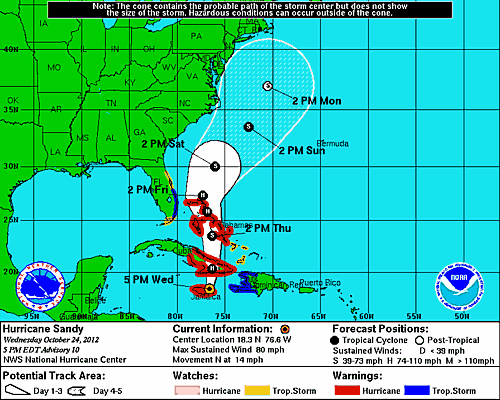A Cuban’s Memories of Hurricane Sandy
Rosa Martínez

HAVANA TIMES — October is coming to an end and, with it, people should start to leave behind their memories of Sandy, the devastating hurricane which affected thousands of people in Cuba’s easternmost region exactly one year ago, leaving the beautiful province of Santiago de Cuba with the most damages.
Sandy devastated the province and caused great losses everywhere it passed. The most painful part of the tragedy, however, was to be captured by the looks of those people who lost their homes and belongings.
Twelve months later, I recall every detail of that tragic night as though it had happened yesterday.
For about two days, all families in the region had been preparing for the hurricane. Renowned Cuban meteorologist Rubiera had announced the inevitable: Sandy would cut through Cuba’s eastern end, crossing the island somewhere between the provinces of Guantanamo and Santiago de Cuba.
Families bought food and fuel to have reserves at home, in case it poured for several days straight or the power was cut. The rains were not that intense, but we had a power cut.
People secured the roofs of their houses with wires and ropes. Some also placed sacks full of sand or stones over the roofs. Drains were cleaned up and trees were pruned. Families living in low-laying areas were evacuated, as were those in homes in very poor condition that were liable to collapse (which were many).
People did all this and more, but the truth of the matter is that no one expected the degree of fury nature unleashed on this corner of the island.

The drizzles began a little after five in the afternoon, at least in the city of Guantanamo where I live. When it got dark, the rains intensified and the power was cut immediately. I still don’t know whether that was a safety measure aimed at preventing accidents or the first of the damage caused by the hurricane.
Santiago de Cuba also experienced a blackout. My last contact with the city was at around eight at night. From two different points in the city, I was told there was no power there.
We waited for hours in the dark, praying, begging Mother Nature not to strike us. Nature cared little for our prayers, however, lashing my city without mercy.
The strong winds began to be felt well before the hurricane entered the country. “The hurricane will enter through Santiago de Cuba,” we heard on the radio. We were at once happy to hear this and concerned over relatives, friends and fellow Cubans living in the neighboring province. “My God, let it not get any stronger than a category 2 hurricane.”
The night was longer than others, or, at least, that’s what it felt like to those of us who saw how the winds began to rip zinc and fibrocement tiles out of people’s roofs. Terrifying thunder and loud crashes were heard all around – it was the sound of objects thrown around by the winds. It felt like a horror movie, one we didn’t want to see (and, unfortunately, had to star in).
The houses that lost their roofs also partially collapsed or suffered other damage. Their owners quickly ran to their neighbors’ homes (luckily, the characteristic hospitality of Cubans was alive and well that night). Some people wept, children cried.
My family and I had taken shelter hours before at my parents’ house, which is very safe. I was unable to hold back tears when I saw part of my roof fly off into the darkness, beneath the rain and in the midst of that cursed storm.
My husband and I had the impulse to run back home and protect our belongings, but my family of course didn’t allow it (wise decision).
We kept an eye out for the neighbors next door the entire night, for their house is in very bad shape. Miraculously, the hurricane left it without a scratch.
Finally, after five or six hours of despair, we stopped hearing the howl of the wind. I thought it was another of the storm’s recesses, of the many we felt throughout the night.
I prayed for that silence to spell the end of the storm, and so it was. Sandy had left the country through the province of Holguin, some neighbors who were trying to recover part of their roofs on the street told us.
Sandy left Cuba at six in the morning, after having destroyed or damaged more than 150 thousand houses in Santiago de Cuba, Holguin and Guantanamo.





